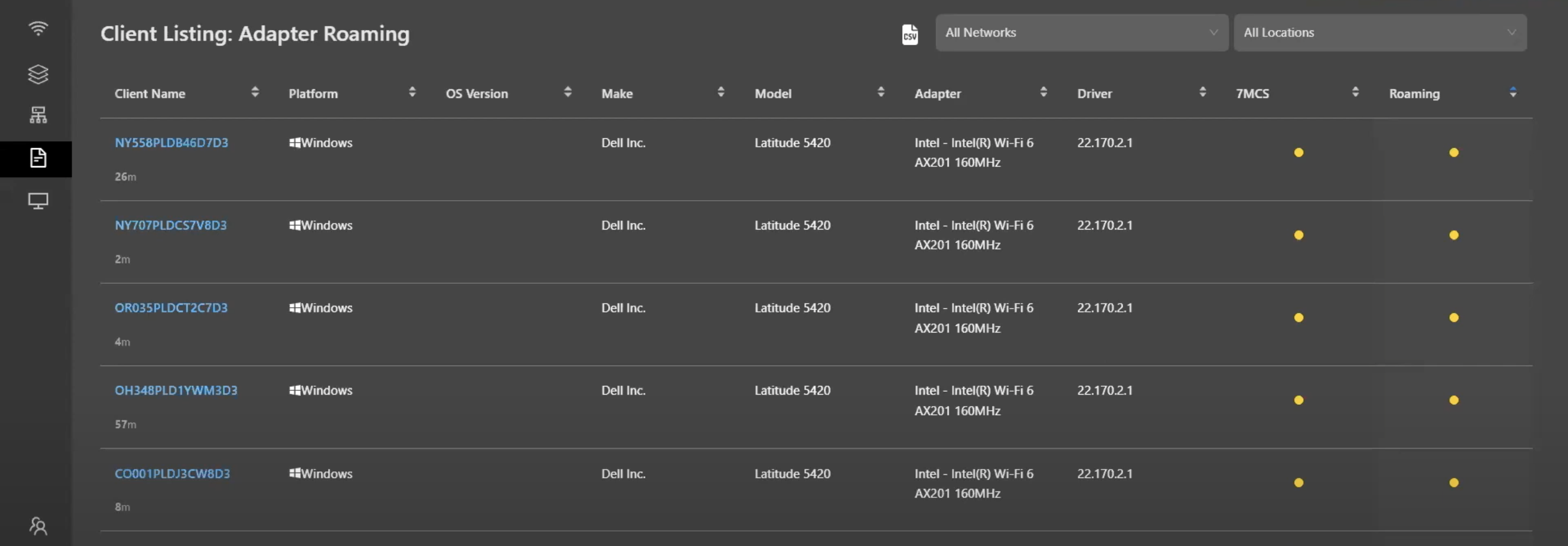
Blog
In order to effectively optimize Wi-Fi connectivity experiences for your users, it’s important to understand how different client adapter and driver combinations perform on your network. In this article, we briefly touch on both Wi-Fi adapters and Wi-Fi drivers and then show how the 7SIGNAL platform can be used to review their performance.
Here’s what we cover in this blog post:
Want to learn more about the 7SIGNAL platform? Chat with our sales team!
What Are Wi-Fi Adapters?
Before we dive into the nitty-gritties, let’s cover the basics. In the world of Wi-Fi, adapters are hardware components that enable devices to pick up Wi-Fi signals and facilitate connectivity to wireless networks.
Typically Wi-Fi adapters are integrated with devices via USB ports, ExpressCard slots, internal PCIs (Peripheral Component Interconnect), or PCI Express slots. They contain radio transceivers that can send and receive wireless signals in accordance with the IEEE 802.11 standard, meaning they can detect nearby Wi-Fi access points (APs) and establish wireless connections with their networks.
What Are Wi-Fi Drivers?
Along the same lines, Wi-Fi drivers are software components that allow devices to communicate with Wi-Fi APs and routers. They’re specialized software modules that are installed on client operating systems to handle the transmission and reception of wireless signals and manage wireless connections.
Wi-Fi drivers typically provide a set of APIs or programming interfaces that applications can use to interact with wireless networks. Drivers are responsible for managing factors such as signal strength, data transfer rates, and security protocols, and ensure that devices can reliably and securely connect to Wi-Fi networks.
How to Review Adapter and Driver Performance
Together, Wi-Fi adapters and drivers play a critical role in ensuring reliable, efficient wireless communications. However, not all drives and adapters are alike. The technology is continually evolving, offering improved performance, new features, and added security capabilities.
As such, in order to maintain high-quality and secure connectivity experiences over your network, it’s important to routinely monitor the adapters and drivers being used to connect the devices in your fleet. These insights can be used to…
- Inform future device acquisitions.
- Proactively troubleshoot connectivity issues.
- Optimize corporate security.
- Bolster mobile device management (MDM) solutions.
- Enhance general IT maintenance.
- And more!
In addition, understanding adapter and driver performance helps ensure that your organization is taking advantage of the latest and greatest Wi-Fi features and technologies.
This is where 7SIGNAL comes in. Our platform includes a Wi-Fi performance agent for mobile and IoT devices that enables you to track just about every Windows, Android, Linux, and MacOS client that connects to your network, with insight into the adapters and drivers they rely on to do so. Here’s how to get started…
1. Deploy 7SIGNAL Endpoint Agents
First, you’ll need to deploy our endpoint agents. These are necessary for acquiring the relevant information from your network. If you’re an existing customer and have already set these up, feel free to skip ahead. If you haven’t, we recommend reading through this introduction to our WLAN monitoring solution before you get too far into the weeds.
2. Launch the 7SIGNAL Platform
Assuming you’re already set with the endpoint agents, launch the 7SIGNAL platform and navigate to the Client Listing: Adapter Roaming dashboard. Here, you’ll find a sortable and searchable list of every single device that has connected to your network. This is what it looks like:
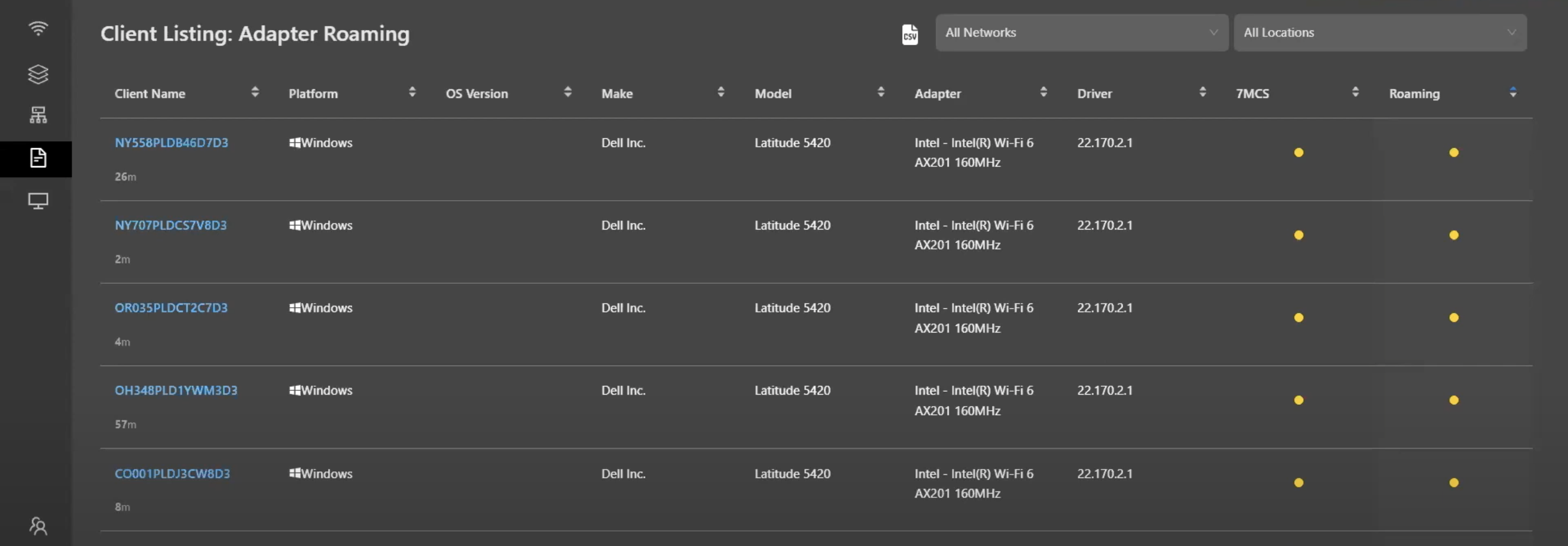
As you can see, it includes a variety of relevant client insights, like client name, platform, version, make, model, adapter, and driver.
In addition, because it tracks client performance insights like roaming score and our patented 7MCS Wi-Fi Experience Score, you can use the dashboard to analyze the effectiveness of different adapter / driver combinations active in your environment.
3. Export Wi-Fi Fleet Data
You can also download data about your Wi-Fi fleet directly from the platform and open it up in Microsoft Excel (or any other data visualization tools that you use). This gives you a little more flexibility with the data, since it allows you to slice and dice it anyway you need.
Check it out, here’s the same data from the image above in excel form:
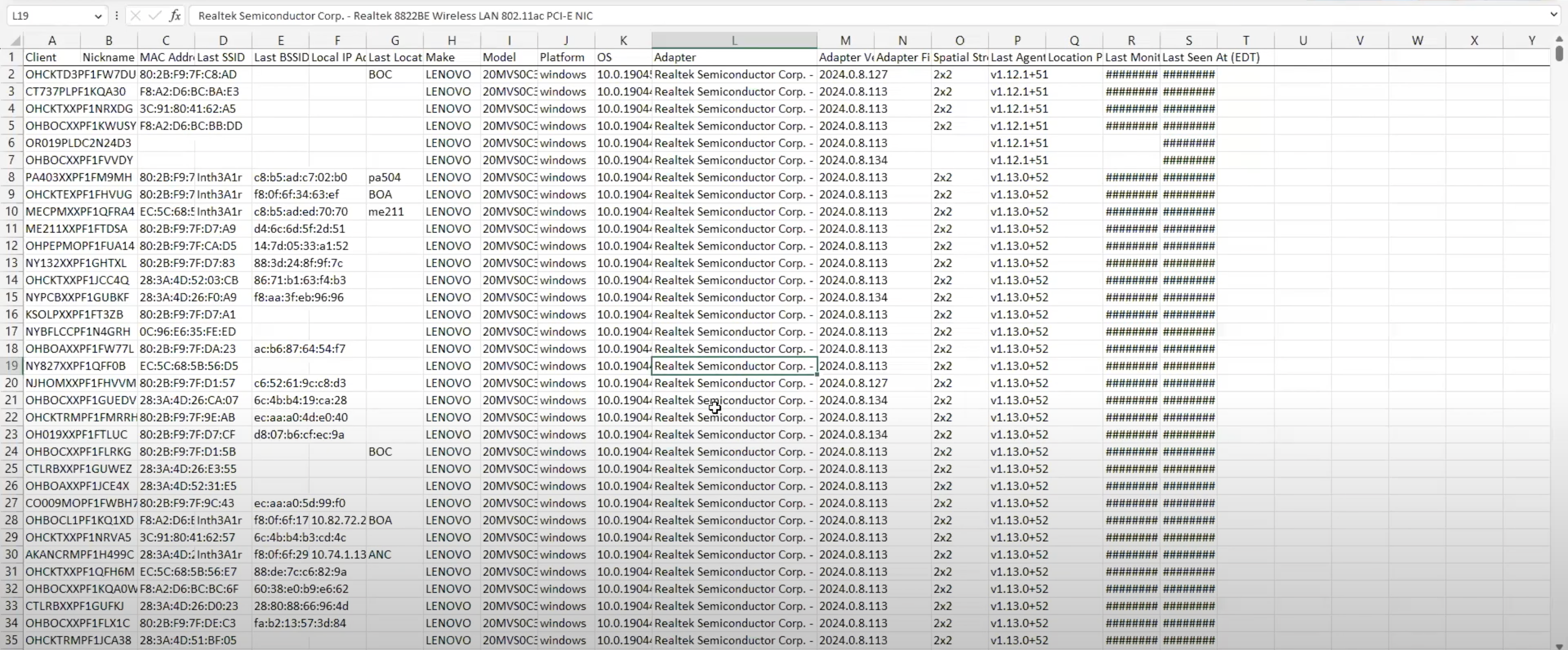
Just as on the dashboard, you’ll have insight into the different clients, adapters, drivers, etc.
4. Review Data in Excel
For those of you using Excel, we recommend creating a pivot table to display the data. Like so:
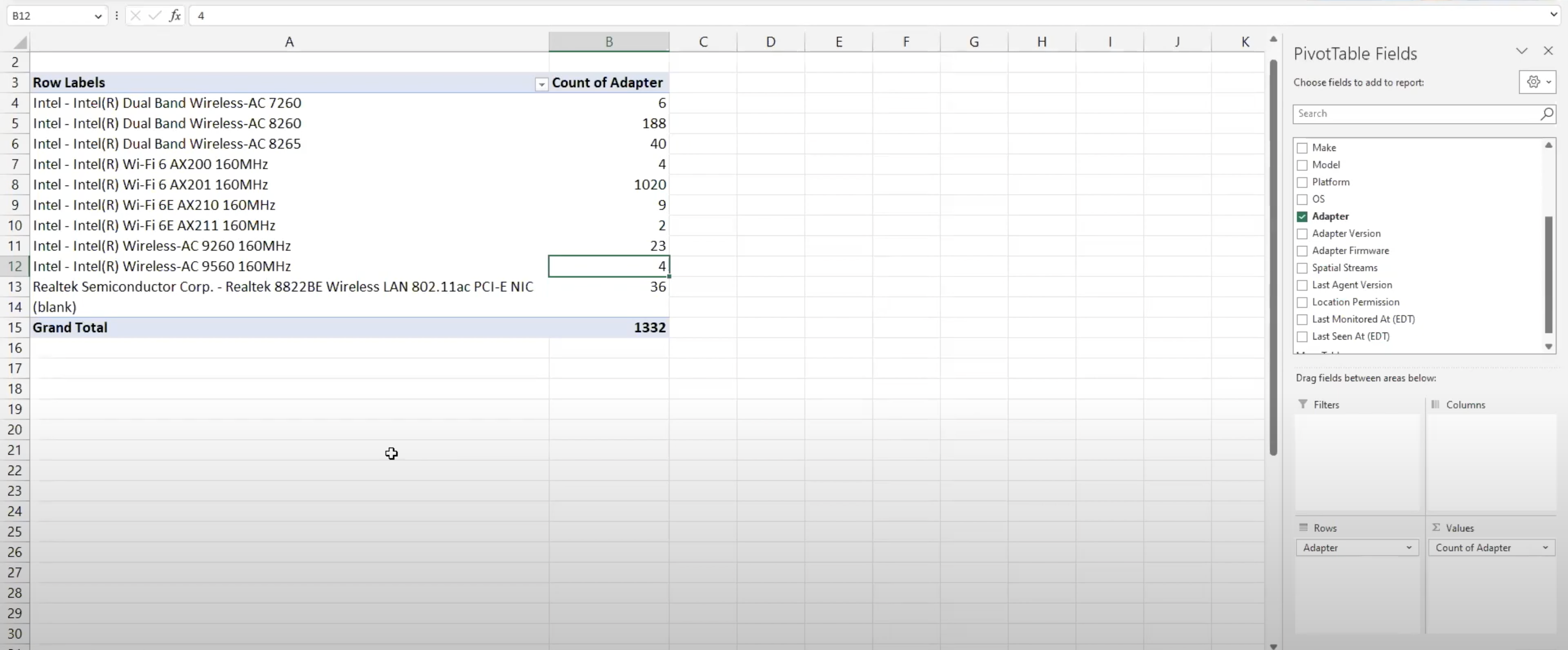
In this case, we added the Adapter column to both the Rows and Values fields. This gave us a list of each adapter type with a count for each type.
In total, 1,332 clients accessed this particular environment. Of these, just over 1,000 used adapters tailored to the Wi-Fi 6 standard. This is an indicator that, if it hasn’t already, the infrastructure should be upgraded to Wi-Fi 6E to take advantage of all the capabilities offered by the standard.
5. Identify Wi-Fi Adapter and Driver Inconsistencies
Taking it a step further, by adding Adapter Version to the Rows field, you can see all the different versions of a particular adapter type that have connected to your environment:
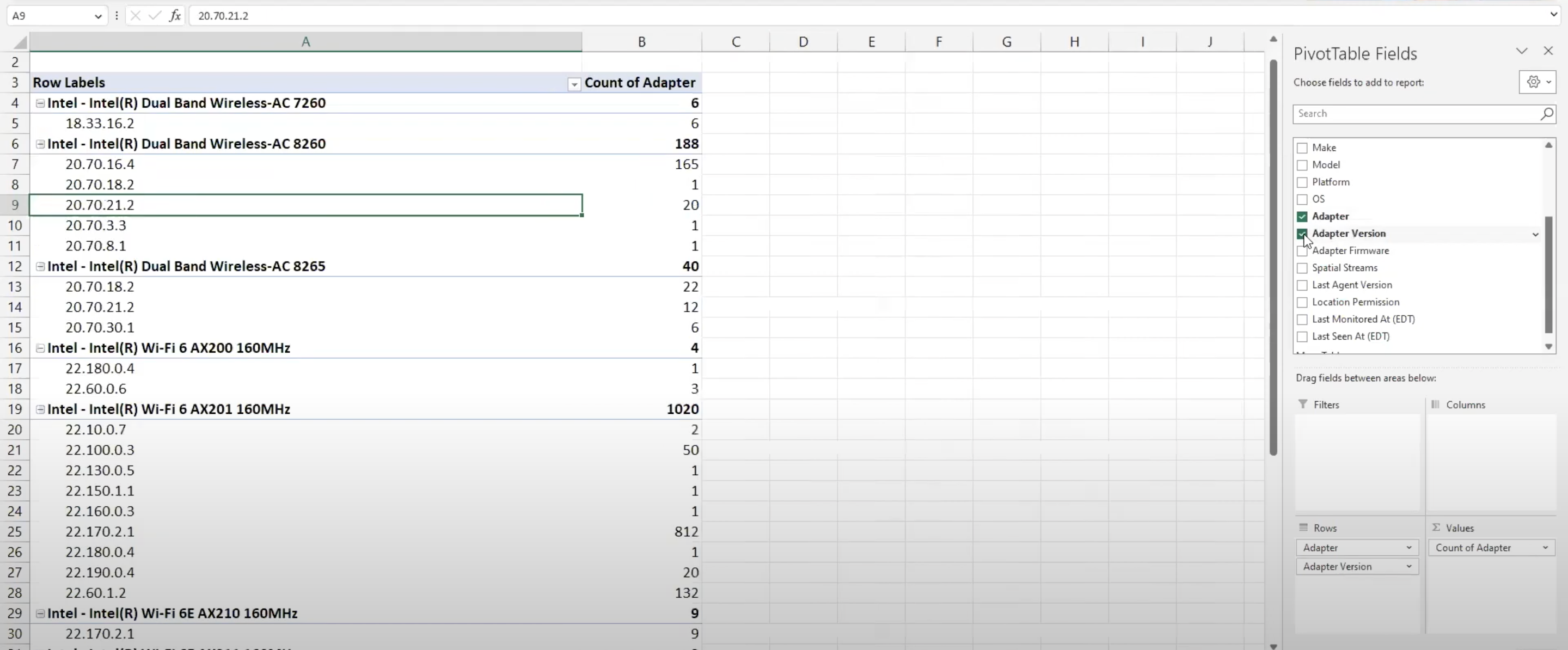
In other words, you can check the version of each adapter and see which ones are out of date. To optimize the performance of your network, you should make sure that there’s relative consistency among your fleet with regard to adapter and driver age. Based on the results of your analysis, you can then determine whether it makes sense to upgrade your infrastructure or acquire new devices for your fleet.
Conclusion
And that’s that! The 7SIGNAL platform enables you to optimize both client adapters and drivers. This helps you ensure high-quality connectivity experiences in your network environment by shoring up issues at a client level. In addition, the data provided by 7SIGNAL can be used to inform future device acquisitions, troubleshoot connectivity issues, optimize corporate security, and more!
Rather watch a video on this subject?
Learn More From the 7SIGNAL Experts
We’re always here to answer your Wi-Fi questions at 7SIGNAL. Our enterprise Wi-Fi optimization platform helps you plan and execute a healthier network. Contact us to learn more.
7SIGNAL® is the leader in enterprise Wi-Fi optimization, providing insight into wireless networks and control over Wi-Fi performance so businesses and organizations can thrive. Our cloud-based platform continually tests and measures Wi-Fi performance at the edges of the network, enabling fast solutions to digital experience issues and stronger connections for mission-critical users, devices, and applications. Learn more at www.7signal.com.